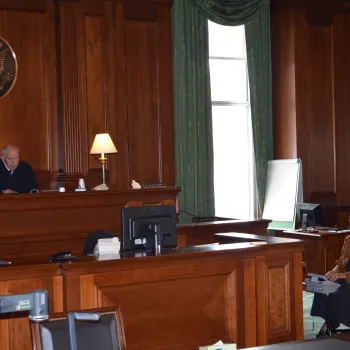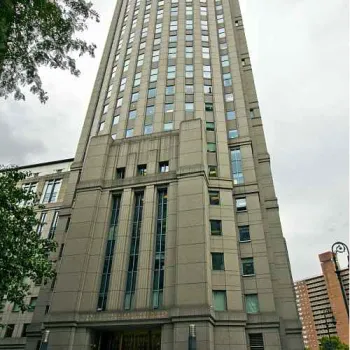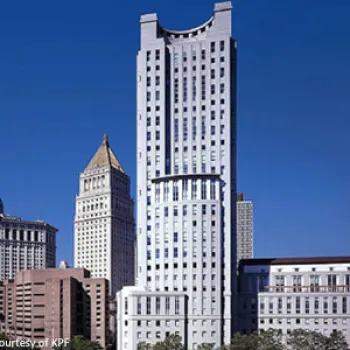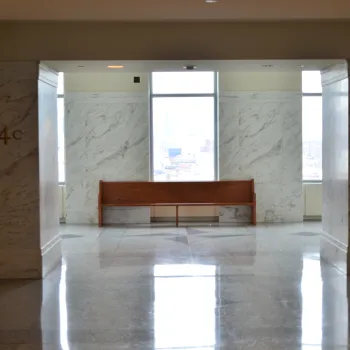UPDATED: November 5, 2012 at 1 p.m.
Hurricane Sandy, which caused widespread chaos throughout the Northeast, has put federal courts based in Manhattan in their worst operational crisis since the 9/11 terrorist attacks. With only gasoline-fueled generator power and widespread interruptions in Internet and telephone service, four federal court buildings in Manhattan were closed for a week, except for a few emergency hearings. Across the East River, a U.S. District Court in Brooklyn had power but no telephone or Internet.
Judges in America’s largest federal trial court struggled to hold hearings in gloomy spaces lit by emergency lamps. Jurors and witnesses were scattered across a region stricken by flood damage and transit shutdowns. Probation officers scrambled to monitor hundreds of criminal defendants who evacuated their homes or were out of reach because of massive power outages.
“There are no lights in judges’ chambers, there are no phones,” New York Southern District Court Executive Edward Friedland said days after the storm left the region. “We’re doing a lot of improvising. Things that normally take 15 minutes can take an hour.”
On Monday, Nov. 5, the first critical steps toward recovery began. After the Daniel Patrick Moynihan U.S. Courthouse, a 27-story court building on Pearl Street in lower Manhattan, regained electrical power over the weekend, the New York Southern District Court and U.S. Court of Appeals for the Second District resumed full operations. But three other Manhattan courthouses, including the bankruptcy court and U.S.International Trade Court, lacked electricity, heat or both, and operations remained severely limited. And federal courts in Manhattan, Brooklyn and New Jersey also remained mired in a regionwide transportation crisis that made it difficult for employees, witnesses and jurors to get to court.
Chief Judge Loretta Preska said the first priority is to reassemble key players for six to seven jury trials that were in progress when the storm hit, including a criminal trial she is presiding over that was getting ready to go to the jury. The case involves the retrial of an attorney who was convicted for his role in a multi-billion-dollar fraud at the defunct commodities broker Refco.
“Obviously, we don’t want too much time to pass,” Preska said. “All of our cases on trial are in dire straits.”
The New York Southern District Court, which handles some of the nation’s most high profile cases, suspended criminal trials for the first time since the 9/11 attacks, before resuming operations Nov. 5. Preska also issued orders extending deadlines in pending criminal and civil cases.
The U.S. Court of Appeals for the Second Circuit, the New York Southern Bankruptcy Court, and the U.S. Court of International Trade, also lost electricity and stopped public operations while working feverishly to reopen. (For the status of all federal courts, visit the court locator.)
Even at the height of the post-storm blackout, the Southern District Court pressed on in a few emergency cases. The day after Hurricane Sandy left the area, a hearing in a case depended on a telephone conference call – challenging in a courthouse without telephone service. One of the litigants finally was able to organize the call on his cell phone. Participants in the call huddled in front of the bench, straining to hear the conversation.
The following day, an emergency hearing in an international child abduction case was held in a gloomy courtroom lit only with a lamp powered by generator. With no audio system, the proceeding was interrupted as the court reporter paused to ask that witnesses repeat themselves.
Away from the public courtrooms, the district’s probation and pretrial office building was completely non-functional. Officers have worked from home and in government-issued vehicles, trying to track down about 3,800 offenders and defendants under their watch. According to Michael Fitzpatrick, chief probation officer for the court, 393 medium and high-risk offenders reside in Manhattan, many beyond oversight because of power outages and storm evacuations.
“Thanks to the mapping feature of PACTS, our case tracking system, we know who we need to see. We just have some areas that are inaccessible,” said Fitzpatrick. “We have people out there all day looking.”
He added that pretrial investigators are limited in their ability to prepare case reports for functions such as bail hearings.
The New York Southern District not only has more judges than any other federal courthouse, it also handles some of the nation’s highest-profile cases. More than 10,000 complaints are filed in this court each year. The court is in the pretrial phase of United States v. Mustafa, a case involving an Islamic cleric accused of aiding al Qaeda. Just before the storm, Rajat Gupta, a former Procter & Gamble CEO and Goldman Sachs chairman, was sentenced to 2 years in prison for insider trading.
Friedland said that even with generators, the power loss slowed the most rudimentary court operations. At the Moynihan courthouse, which houses the Southern District Court and the Court of Appeals, 90 percent of electrical sockets are dead. Of more than 20 elevators, only three were functioning the week of the storm. During a bail hearing Tuesday, staffers were running up and down darkened stairways to bring documents to and from the few functioning copy machines.
Other necessities also have been disrupted by the power loss. On Thursday after the storm, Judge Preska roamed the court’s hallways, feeding court staff with pizza and other food she had purchased outside the power-outage zone.
Electricity is not the only challenge facing the Manhattan Courts. Other major challenges will persist even after the power grid is restored.
Public transportation remained in disarray inside and outside the city, including a total shutdown in southern Manhattan, making it difficult to get employees, jurors and witnesses to the court. A lack of heat, and in some cases telephone and iInternet service, persisted even after lights went back on.
A number of steps are being taken to restore order and create courtroom capacity. Plans were being made to schedule some hearings in an emergency backup courthouse in White Plains, located north of the city. Courts outside the city have volunteered space for hearings and for judges to work.
The Administrative Office of the U.S. Courts and its Judiciary Emergency Response Team have helped the court get back on its feet, coordinating communications with the Federal Emergency Management Agency and others, providing special expedited contract authority, and reestablishing information technology and web systems.
Chief Judge Preska has been deeply gratified by all the efforts to keep the justice process moving, even when most of the lights are out.
“The people who run our building have been splendid,” Preska said. “The staff has been here day and night.”
Subscribe to News Updates
Subscribe to be notified when the news section is updated.




